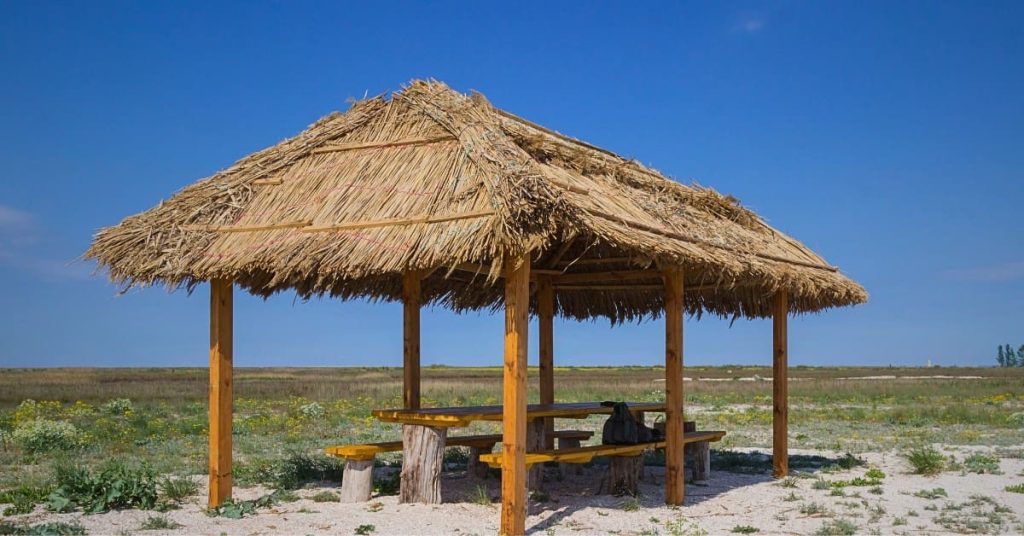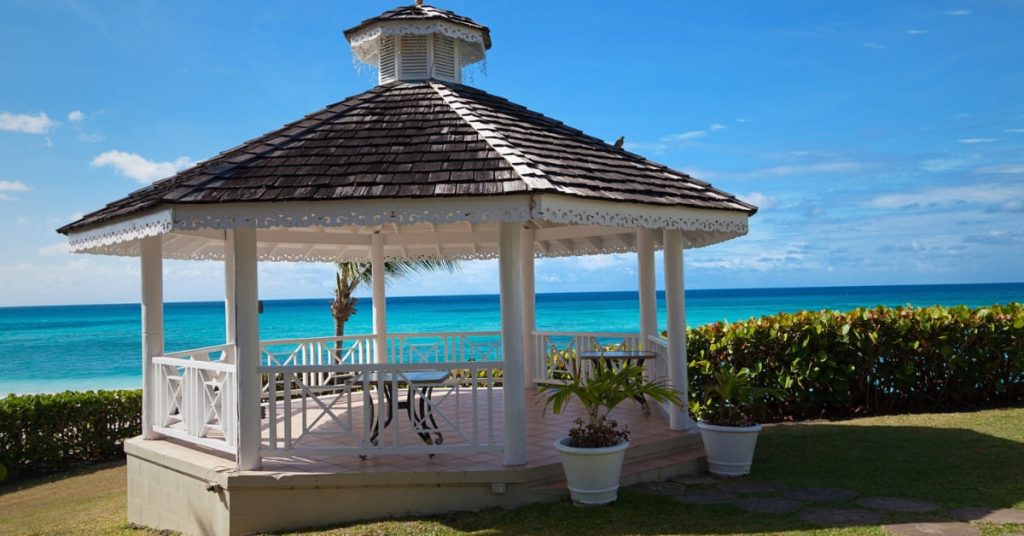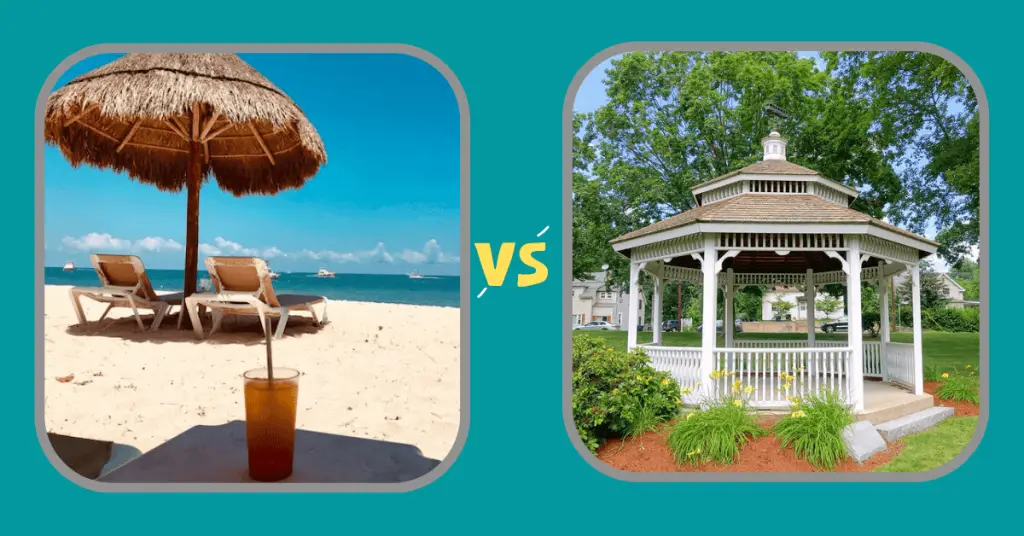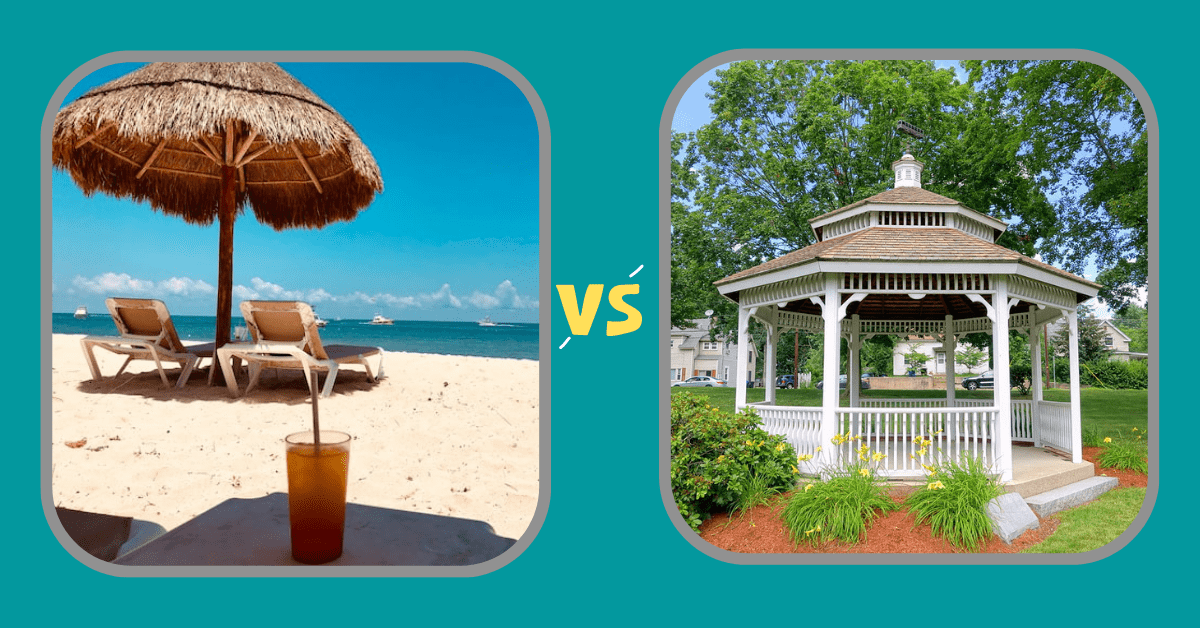Are you looking for a way to put the perfect finishing touch on your backyard oasis, or do you need an ideal spot for outdoor weddings and special events? It can be hard to decide whether a gazebo or palapa is suitable.
Both have advantages, but what’s best suited for you depends on the details. I’m here to help make that decision more manageable by breaking down all the critical differences in this blog!
Palapa vs Gazebo: A palapa and a gazebo are outdoor structures but differ in design and materials. A palapa is a traditional Mexican shelter with a thatched roof made of palm fronds or grass supported by wooden poles. In contrast, a gazebo usually has a solid roof made of wood, metal, or fabric and is more commonly found in gardens or parks.
Palapa vs Gazebo:
Palapas and gazebos offer different advantages for outdoor events, special occasions, and backyards. Here 1 will help you understand the significant differences between these two types of structures, so you can decide which one to choose for your needs.
What is a Palapa?

A palapa is a traditional Mexican structure with a thatched roof made of leaves and branches. It’s often used to provide shade from the sun and protection from the elements, but it can also serve as an area for family gatherings or even special events.
Palapas are typically round, and their style gives off a warm, inviting feel.
From beachfront paradises to backyards across the land, palapas offer a unique and timeless way of protecting from sun and rain.
These Mexican structures have been captivating for centuries with their simplistic design, only one pole at its center, but in the modern world, more poles are also adjusted for a bigger dream and open sides for ventilation. Yet, they also boast incredible beauty that can enhance any space.
So if you’re looking to shake things up around your place or give yourself some shelter during those hot summer days, why not consider adding a masterpiece of cultural heritage called the palapa?
In recent years, palapa roofs have soared in popularity all across the globe. From Mexico to Hawaii and the Caribbean beyond, these eye-catching structures can add a distinct style of beauty – without breaking your budget.
Whether for residential or commercial use, more people are discovering what makes palapas so unique!
What is a Gazebo?

A gazebo, conversely, is a freestanding structure typically made of wood or metal, with an open roof and sides that can be covered by curtains or mesh screening to provide wind protection.
Gazebos are usually square or octagonal and have a more formal feel than palapas.
Pavilions have been famous in the Middle East as ornamental garden structures for centuries. Now, thanks to their popularity worldwide, gazebo styles and sizes are vast – from rustic wooden designs to exotic engineering feats of craftsmanship!
They make a great centerpiece outdoors and can be used year-round, regardless of the weather. So let your creativity run wild in this age-old tradition because there’s sure to be an ideal style that fits you perfectly!
Differences between Palapa and Gazebo

Size:
Gazebos are usually larger than palapas, so if you’re looking for something to fit a larger group of people or make an impactful statement in your backyard, a gazebo is the way to go.
Shapes:
With so many different designs, gazebos can help you create the perfect backyard oasis. Whether it’s a traditional six-sided gazebo or an elliptical one with rounded edges – no matter your preference, each shape offers excellent functionality without compromising style.
When compared to Gazebos, Palapas are typically identified by their thatched roofs. These palapa structures come in two styles: single-pole support and four poles. Whatever suits your needs best!
Construction:
Palapas are made of natural materials, which makes them more environmentally friendly and cheaper than gazebos. However, they require more maintenance because the roof needs to be restored or replaced every few years.
Gazebos, on the other hand, can last much longer with minimal upkeep.
Wooden gazebos provide an elegant, natural look for any backyard, while vinyl and aluminum options are ideal for those looking to go easy on maintenance yet stay strong.
For beachfront homes, opt for palapas with beautiful dried palm leaf roofs – giving you an instant tropical touch!
Aesthetics:
Palapas have a rustic look that goes great with tropical themes or settings, while gazebos offer a more formal appearance that fits well with traditional home styles.
Functionality: Palapas provide shade and some protection from the elements, but gazebos offer better wind protection due to their walls and screening options.
Regular Maintenance:
Gazebos sure look good, all classic and grand, but behind the scenes, it’s a different story. Made out of wood or metal, Gazebos require regular sealing and painting to keep deterioration at bay if you want them to look their best for years.
On the other hand, Palapas are more naturally resilient when it comes to maintenance typically made from thatched palm fronds; they’re not too bothered by mother nature! But despite this extra work (and expense), many people still opt for Gazebos due to their timeless style…
Utilization Purpose:
Gazebos have been around since ancient times, used by seekers of inner peace. Devotees would use these structures in temples and other sacred places to escape noise and distraction – a place to relax or meditate in quiet solitude.
Fast forward to today: Gazebos can be found in many more settings as versatile outdoor spaces! Whether you’re looking for shelter from the elements, a cozy spot with family or friends, or planning micro-meetings outdoors – there’s no limit to creativity; turn your gazebo into an ‘outdoor room’ if that suits your fancy!
Palapas are the perfect addition to any outdoor area, providing a vast umbrella-like structure that can protect from damaging UV rays and unexpected storms.
But these versatile shelters don’t just offer protection – you can use them for various activities; I’ve seen palapas turned into barbecue stations around pool areas, kitchens for backyard feasts with friends, or simply as extra storage space tucked away in gardens!
Pricing:
Backyard gazebos can add a touch of elegance to your outdoor space – with prices ranging from around five thousand dollars for the basics up to thousands more.
It all depends on what kind you’re looking for; pre-made designs or custom kits may cost extra if they come accessorized.
Palapas are the perfect way to add a tropical vibe to your outdoor settings – and if you’re looking for quality without breaking the bank, Palapa King is your go-to source.
Their palapa kits come in various sizes with prices ranging from $700 – $3500 sure, it’s a bit of an investment but worth every penny!
FAQs:
Q:1 What is the lifespan of a palm leaf roof?
With the right harvesting process, a Palma Real thatch roof can last an impressive 10-20 years. Though this type of roofing has its downsides – like creating a microclimate below and offering birds an inviting nesting spot – when appropriately harvested, you will get decades’ worth of use out of it.
Q:2 What’s the difference between a cabana and a gazebo?
The main difference between cabanas and gazebos is the material they are made out of. While cabanas typically have a fabric roof, usually made of canvas or nylon, gazebos often have a solid wooden or metal frame with latticework and screening to protect them from the elements.
Gazebo roofs are usually made of metal or shingles, while cabanas may be built from wood or other materials. Here is the guide.
Q:3 How much does it cost to build a palapa?
Palapa King offers quality palapa kits in various sizes, from $700 to $5500. The cost of a palapa depends on the size and design you choose. Customized designs may cost more, as do accessories like benches and tables for additional seating.
Q:4 What is the difference between a gazebo and a pavilion?
The main difference between a gazebo and a pavilion is the roofing. Pavilions are usually built with either open or closed sides, but with an open roof.
Gazebos are typically built with a closed roof and may feature latticework or screening to protect from the elements. They can also have open sides or be completely enclosed.
Q:5 What is the difference between a gazebo and a pergola?
The main difference between a gazebo and a pergola is the roofing. Pergolas are built with an open roof, usually made from wooden beams or metal bars. Gazebos may have open sides or be completely enclosed, and usually feature a solid roof made from metal or shingles for added protection. Here is the detailed guide.
Q:6 Where would be the best place to build a palapa at home?
The best place to build a palapa in your backyard would be near the pool or patio area. This way, you and your guests can enjoy a shady spot to relax and take in the outdoors.
You can also build one near outdoor seating areas or your kitchen for additional space.
Conclusion
Are you stuck deciding between a palapa and a gazebo for your outdoor space? Palapas are the traditional, tropical go-to with thatched palm leaves.
On the other hand, Gazebos can be made from materials such as wood or metal – plus bonus points if it has an interior seating area! And while both structures provide perfect settings to relax in nature, for many people, the decision comes down to what’s important: dining alfresco or having an awesome seating spot…
I hope you will be well aware of Palapa vs Gazebo and how to make a perfect outdoor area with any of these two structures. Feel free to contact us if you have any queries.

